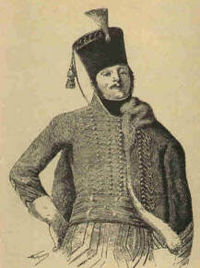- Claude Pierre Pajol
-
Claude Pierre Pajol 
Claude Pierre PajolBorn 10 May 1775
Aups, FranceDied 20 March 1844 (aged 68)
Paris, FranceAllegiance  First French Republic, First French Empire
First French Republic, First French EmpireService/branch Cavalry Years of service 1789–1815 Rank général de division Claude-Pierre, Comte de Pajol (3 February 1772-20 March 1844), was a French cavalry general and military commander during the French Revolutionary and Napoleonic Wars, and political figure.
Contents
Early life and career
Born in Besançon, as the son of a lawyer, he was intended to follow his father's profession, but the events of 1789 turned his mind in another direction. Joining the battalion of Besançon, he took part in the political events of that year, and in 1791 went to the French Revolutionary Army of the Upper Rhine with a volunteer battalion.
He took part in the campaign of 1792 and was one of the stormers at Hochheim (1793). From the Count of Custine's staff he was transferred to that of Jean Baptiste Kléber, with whom he took part in the Sambre and Rhine Campaigns (1794-96). After serving with Louis Lazare Hoche and André Masséna in Germany and Switzerland (1797-99), Pajol took a cavalry command under Jean Victor Marie Moreau for the campaign on the upper Rhine.
First Empire
In the short years of peace Pajol, now colonel, was successively envoy to the Batavian Republic, and delegate at Napoleon I's coronation (the start of the First French Empire). In 1805, the emperor employed him with the light cavalry. He distinguished himself at the battle of Austerlitz, and, after serving for a short time in the Italian Peninsula, he rejoined the Grande Armée as a general of brigade, in time to take part in the campaign of Friedland. The next year (1808) he was made a Baron d’Empire.
In 1809 he served on the Danube, and in the Russian War of 1812 led a division, and afterwards a corps, of cavalry. He survived retreat, but his health was so broken that he retired to his native town of Besançon for a time. He was back again in active service, however, in time to be present at the battle of Dresden, in which he played a conspicuous part. Again wounded in the battle of Leipzig, Pajol was created a count of the Empire on 25 November 1813.
In 1814 he fought in the Six Days Campaign, commanding a corps of all arms in the Seine Valley. On the fall of Napoleon, Pajol gave in his adhesion to the Restoration government, but he rejoined the Emperor immediately upon his return to France. The Ist corps of cavalry under his leadership played a prominent part in the campaign of 1815, both at Ligny and in the advance on the Wavre under the Marquis de Grouchy. On receiving the news of the battle of Waterloo, Pajol disengaged his command, and skillfully retreated to refuge in Paris. There he and his men played an active part in the actions which ended the war.
Later life
The Bourbons, on their return, dismissed him, although this treatment was not, compared to that applied to Michel Ney and others, excessively harsh. In 1830 he took part in the July Revolution and the overthrow of Charles X. He suppressed the riots in Paris in 1831 and 1832, 1834 and 1839. A general, and a peer of France, he was put on the retired list in 1842 and died two years later.
His son, Count Charles Paul Victor Pajol (1821-1891), entered the army and had reached the rank of général de division when, during the Franco-Prussian War, he was involved in the catastrophe of Metz (1870). He retired in 1877. Besides being judged a competent soldier, he was a sculptor of some merit, who executed statues of his father and of Napoleon, and he wrote a life of his father and a history of the wars under Louis XV (Paris 1881-1891).
References
- Hugh Chisholm, ed (1911). The encyclopædia britannica. 20 (11 ed.). At the University press. http://books.google.com/books?id=_EgEAAAAYAAJ&pg=PA521&lpg=PA521&dq=Charles+Paul+Victor+Pajol&source=bl&ots=e0_i0HoMUT&sig=YLJIjiUSpp0sgFqsAnbt4SFSqJY&hl=en&ei=ybBqTJbRFsSclge4ydysAQ&sa=X&oi=book_result&ct=result&resnum=2&ved=0CBUQ6AEwAQ#v=onepage&q=Charles%20Paul%20Victor%20Pajol&f=false.
 This article incorporates text from a publication now in the public domain: Chisholm, Hugh, ed (1911). Encyclopædia Britannica (11th ed.). Cambridge University Press.
This article incorporates text from a publication now in the public domain: Chisholm, Hugh, ed (1911). Encyclopædia Britannica (11th ed.). Cambridge University Press.
Categories:- 1772 births
- 1844 deaths
- People from Besançon
- Counts of the First French Empire
- French military personnel of the French Revolutionary Wars
- French commanders of the Napoleonic Wars
- French generals
- Military leaders of the French Revolutionary Wars
Wikimedia Foundation. 2010.
